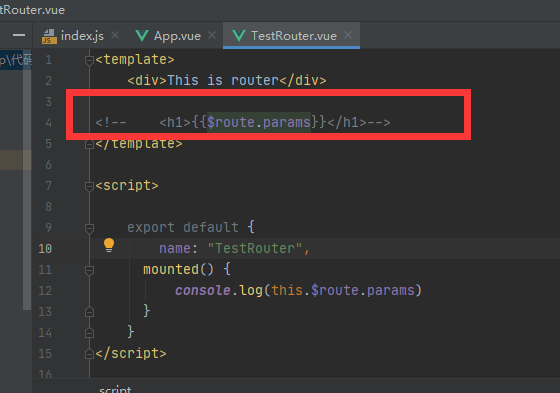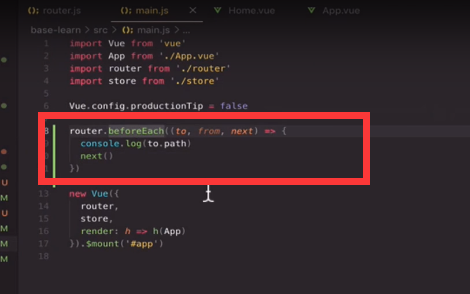第一个小程序 router-link-路由的跳转

<template> <div id="app"> <div>hello world!</div> <router-view></router-view> </div> </template> <script> export default { name: 'App' } </script>

import Vue from 'vue'
import Router from 'vue-router'
// import Hello from "@/components/Hello";
Vue.use(Router)
export default new Router({
routes: [
{
path: '/',
},
{
path: '/hello',
name: 'Hello',
// component: Hello // 上下两种写法都ok,下面这种使用的是懒加载
component: () =>
import(/* webpackChunkName: "download" */ '@/components/Hello.vue')
}
]
})

<template> <div> <h1>hello router!</h1> </div> </template> <script> export default { name: "Hello" } </script> <style scoped> </style>
注:这里有个坑, vue-cli@3上面这个程序就报错
怎么回事呢,我用pycharm专业版的,安装了一个VUE
写这样的程序就报错了,至于为啥我也不知道,还有个报错,同样的代码放到2.13版本就一点问题也没有

路由懒加载
{
path: '/hello',
name: 'Hello',
// component: Hello // 上下两种写法都ok,下面这种使用的是懒加载
component: () =>
import(/* webpackChunkName: "download" */ '@/components/Hello.vue')
}
编程式导航,也可以理解为函数里面设置跳转
<template> <div id="app"> <img src="./assets/logo.png"> <!-- <router-link to="/test">aaa</router-link>--> <button @click="toTest">跳转按钮</button> <router-view/> </div> </template> <script> export default { name: 'App', methods:{ toTest:function(){ this.$router.push({path:"/test"}) // 就是这一句,注意是router,不是route } } } </script> <style> #app { font-family: 'Avenir', Helvetica, Arial, sans-serif; -webkit-font-smoothing: antialiased; -moz-osx-font-smoothing: grayscale; text-align: center; color: #2c3e50; margin-top: 60px; } </style>
动态路由 -- 我记住这个坑了
什么是动态路由?
举个例子吧:http://localhost:8080/#/test/23232 ,后面的数据是变动的,这个就是动态路由
对路由进行操作用router,获取参数用route
先说这里有一个坑, 只要在html里面写这个{{$route.params}}, 报错,为什么呢,因为temlpate里面只能有一个子元素
Component template should contain exactly one root element. If you are using v-if on multiple elements, use v-else-if to chain them instead.


解决办法, 这样就搞定了

上代码

import Vue from 'vue'
import Router from 'vue-router'
// import HelloWorld from '@/components/HelloWorld'
import TestRouter from '@/components/TestRouter'
Vue.use(Router)
export default new Router({
routes: [
{
path: '/'
// name: 'HelloWorld',
// component: HelloWorld
},
{
path: '/test/:id',
name: 'TestRouter',
component: TestRouter
}
]
})

<template> <div id="app"> <img src="./assets/logo.png"> <button @click="toTest">跳转按钮</button> <router-view/> </div> </template> <script> export default { name: 'App', methods:{ toTest:function(){ this.$router.push({path:"/test/23232"}) // 这里链接也要加id,要不报错 } } } </script> <style> #app { font-family: 'Avenir', Helvetica, Arial, sans-serif; -webkit-font-smoothing: antialiased; -moz-osx-font-smoothing: grayscale; text-align: center; color: #2c3e50; margin-top: 60px; } </style>

<template> <div></div> <div>This is router</div> <div>{{$route.params.id}}</div> </template> <script> export default { name: "TestRouter", mounted() { console.log(this.$route.params) } } </script> <style scoped> </style>
嵌套路由

import Vue from 'vue'
import Router from 'vue-router'
// import HelloWorld from '@/components/HelloWorld'
import TestRouter from '@/components/TestRouter'
Vue.use(Router)
export default new Router({
routes: [
{
path: '/'
// name: 'HelloWorld',
// component: HelloWorld
},
{
path: '/test/:id',
name: 'TestRouter',
component: TestRouter,
children:[{
path: '/child',
component: () =>
import(/* webpackChunkName: "download" */ '@/components/Child.vue')
}]
}
]
})

<template> <div id="app"> <img src="./assets/logo.png"> <button @click="toTest">跳转按钮</button> <router-view/> </div> </template> <script> export default { name: 'App', methods:{ toTest:function(){ this.$router.push({path:"/test/23232"}) // 这里链接也要加id,要不报错 } } } </script> <style> #app { font-family: 'Avenir', Helvetica, Arial, sans-serif; -webkit-font-smoothing: antialiased; -moz-osx-font-smoothing: grayscale; text-align: center; color: #2c3e50; margin-top: 60px; } </style>

<template> <div> <div>This is router</div> <div>{{$route.params.id}}</div> <router-view></router-view> // 嵌套路由需要加这句 </div> </template> <script> export default { name: "TestRouter", mounted() { console.log(this.$route.params) } } </script> <style scoped> </style>

<template> <div> <div>this child</div> </div> </template> <script> export default { name: "Child" } </script> <style scoped> </style>
动态路由传参

import Vue from 'vue'
import Router from 'vue-router'
// import HelloWorld from '@/components/HelloWorld'
import TestRouter from '@/components/TestRouter'
Vue.use(Router)
export default new Router({
routes: [
{
path: '/'
// name: 'HelloWorld',
// component: HelloWorld
},
{
path: '/test/:id',
name: 'TestRouter',
component: TestRouter,
children:[{
path: '/child',
component: () =>
import(/* webpackChunkName: "download" */ '@/components/Child.vue')
}]
}
]
})

<template> <div id="app"> <img src="./assets/logo.png"> <button @click="toTest">跳转按钮</button> <router-view/> </div> </template> <script> export default { name: 'App', methods:{ toTest:function(){ this.$router.push({name:"TestRouter", params:{id: 'asdfadf'}}) // 注意下面这句,如果用path的话,如果path不符合规则,则报错 // 通常动态路由传参,都用name的方式,也就是路由里面写的name,上面的方式 // this.$router.push({path:"/test/1232", params:{id: 'asdfadf'}}) } } } </script> <style> #app { font-family: 'Avenir', Helvetica, Arial, sans-serif; -webkit-font-smoothing: antialiased; -moz-osx-font-smoothing: grayscale; text-align: center; color: #2c3e50; margin-top: 60px; } </style>

<template> <div> <div>This is router</div> <div>{{$route.params.id}}</div> <!-- <router-view></router-view> // 嵌套路由需要加这句--> </div> </template> <script> export default { name: "TestRouter", mounted() { console.log(this.$route.params) } } </script> <style scoped> </style>
导航守卫 --main.js 类似钩子函数,必须有next(),否则夯住


